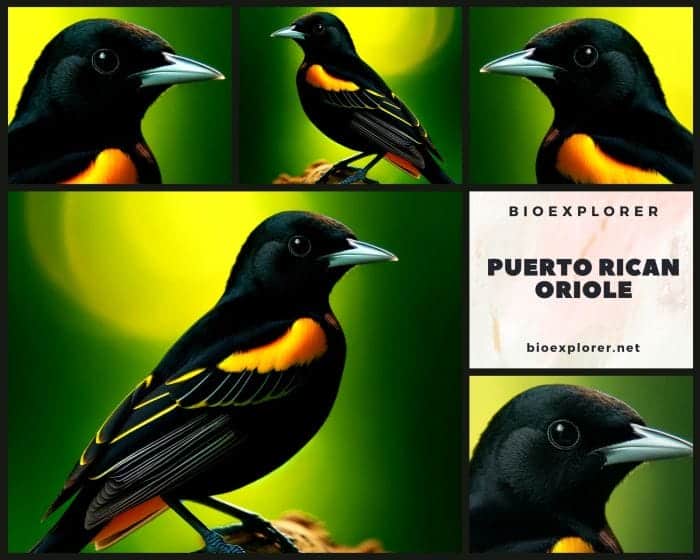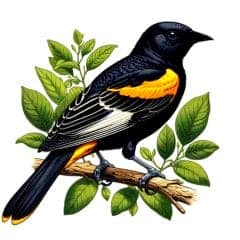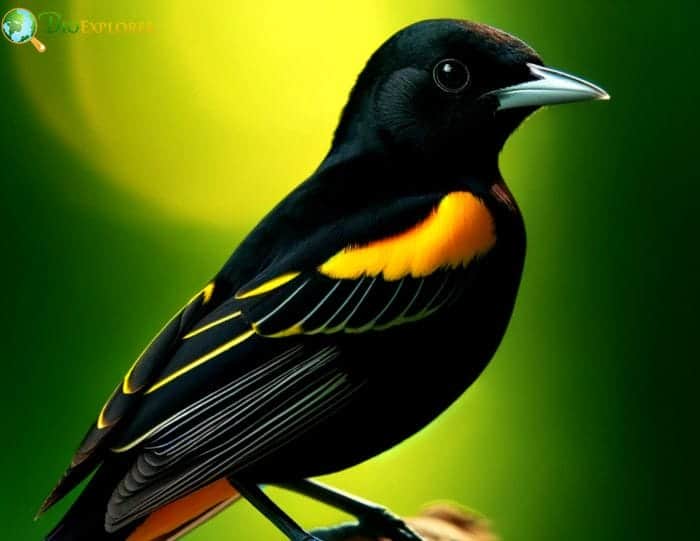
| Animalia | Passeriformes | Icteridae | Icterus | Icterus portoricensis |
The Puerto Rican Oriole (Icterus portoricensis) is a striking black and yellow New World oriole measuring about 4 inches long. Weighing 36-41 grams, this species displays unusually little size or color differentiation between the sexes. Instead, males and females share bright breeding plumage mixing black upperparts with yellow bellies and shoulders.


- Common Name(s): Puerto Rican Oriole
- Family: Icteridae
- Body Dimensions: 22-26 cm
- Male Plumage Color(s): Black With Yellow Belly and Shoulder
- Female Plumage Color(s): Black With Yellow Belly and Shoulder
- Habitat: Forests and Brush
- Diet: Fruit, Insects, Lizards, Nuts
- Native Countries: Puerto Rico
- Continent(s): North America
- Taxonomy Classification Year: 1866
- Taxonomist(s): Henry Bryant
Puerto Rican Oriole Fun Facts

- Even the songs of both sexes sound similar, unlike many temperate-zone songbirds with distinctive male-only vocalizations.
- Endemic across wooded Puerto Rican habitats from mangroves to rainforest, the Puerto Rican Oriole feeds on diverse fare from fruit to insects to small vertebrates foraged from trees and dense vegetation.
- Breeding February-July, females construct intricate hanging basket nests of woven palm fibers under leaves, laying around 3 white eggs with lavender speckles.
- Monogamous pairs share parental duties of incubating eggs and feeding chicks.
- While once considered the same species as Cuban, Hispaniolan, and Bahama orioles, the Puerto Rican Oriole was recognized as a distinct endemic taxon in 2010.
- However, ongoing threats from Habitat Loss and brood parasitism of its specialized palm nests by Shiny Cowbirds still loom over this island songster.
- Protecting stands of mature palms interspersed through coastal and mountain forests helps ensure suitable nesting sites.
- As a charismatic frugivore/insectivore playing keystone ecosystem roles, the conservation of the Puerto Rican Oriole provides an umbrella for preserving vital insular biodiversity.
Maintaining these last Caribbean strongholds for a genetically unique oriole highlights Puerto Rico’s responsibility to steward the Puerto Rican Oriole’s restricted endemic range.
![]()
Suggested Reading: Birds of Puerto Rico
Cite This Page
APA7MLA8Chicago
BioExplorer.net. (2025, December 07). Puerto Rican Oriole. Bio Explorer. https://www.bioexplorer.net/animals/birds/puerto-rican-oriole/.
BioExplorer.net. "Puerto Rican Oriole" Bio Explorer, 07 December 2025, https://www.bioexplorer.net/animals/birds/puerto-rican-oriole/.
BioExplorer.net. "Puerto Rican Oriole" Bio Explorer, December 07 2025. https://www.bioexplorer.net/animals/birds/puerto-rican-oriole/.











